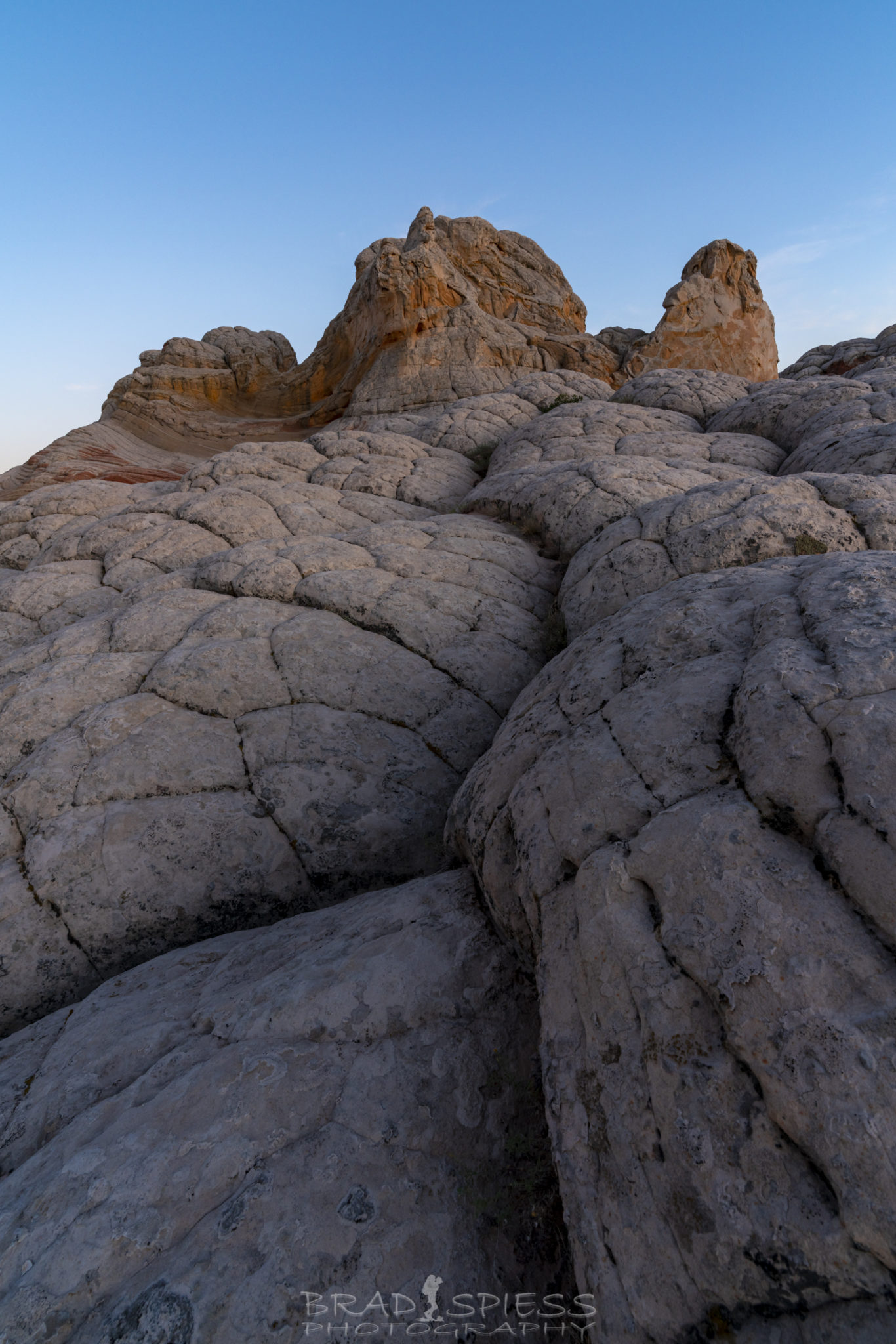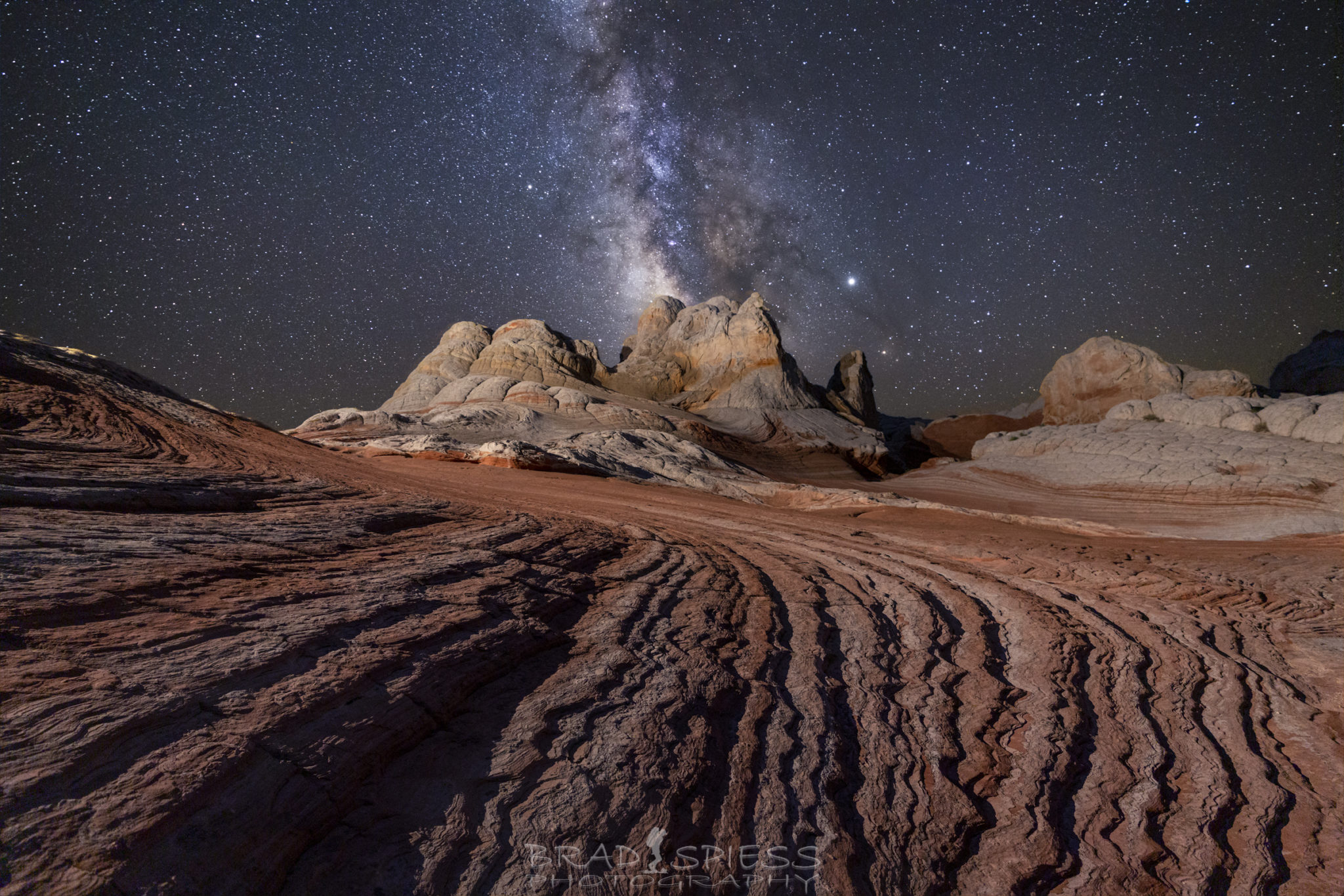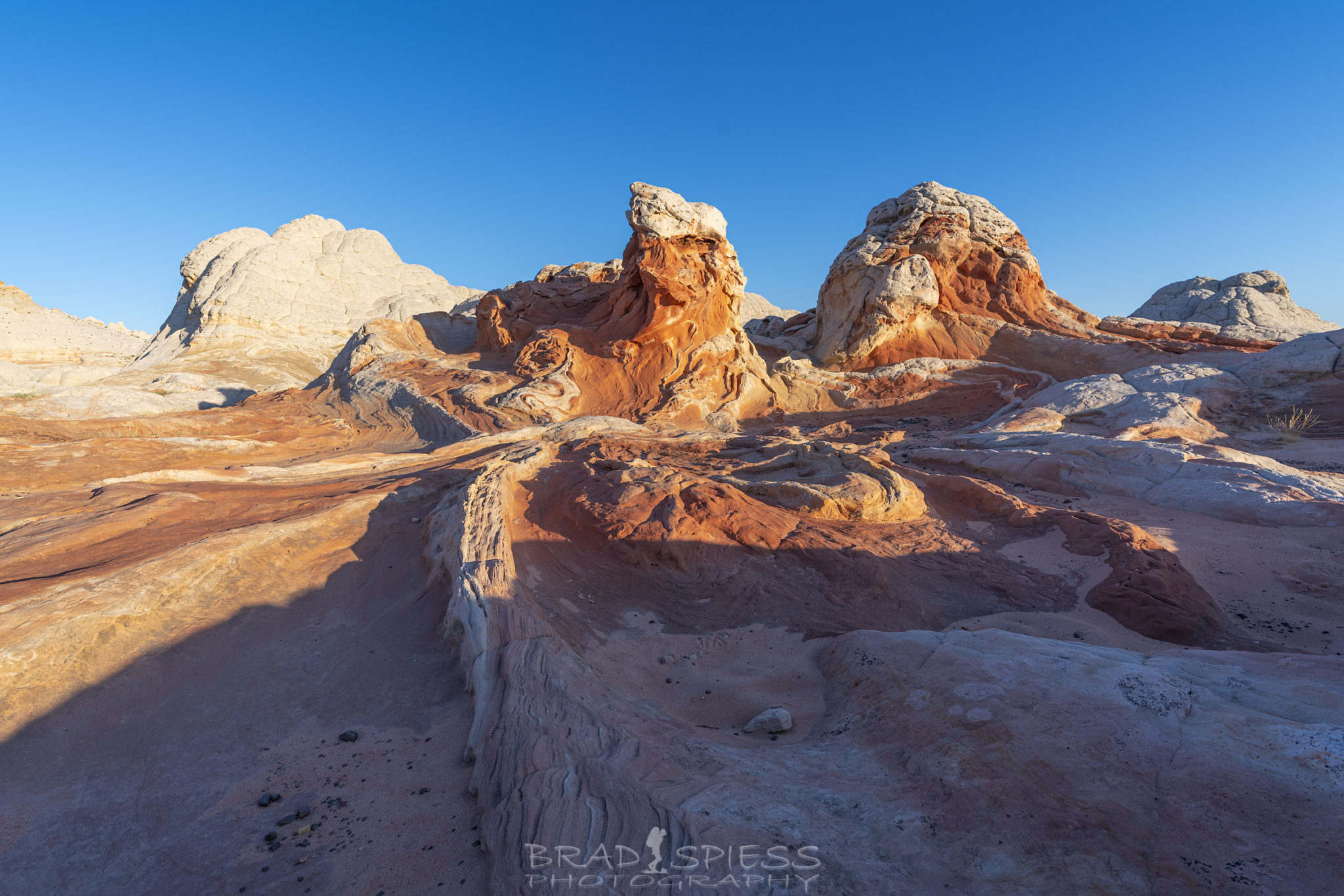My White Pocket Trip
The White Pocket Workshop
Black and White treatment of the White Pocket landscape
Day 1
After taking our time breaking down camp in Zion we got on the road and made our way towards Kanab for the start of our White Pocket Workshop. The workshop check in was at 11am, we left Zion around 9 am for about an hour long drive just to give us some wiggle room just in case. It was a pretty drive out of the park as we looked at all the spots we would love to stop and check out but did not have time to. I checked out the area east of the tunnel on my way out last year and really had a good time and would highly suggest it. We made it to Kanab ahead of schedule and were not able to check in or even get into the room set up for the workshop because the hotel was not ready for anyone so we took that time to explore the tiny little town for a little bit and get some coffee before finally checking into the workshop.
We figured out why they probably were not able to let us start early because the workshop is held on the sub level were breakfast was being served in the morning so the hotel needed time to break that down and get our conference room ready for us before letting us in. We all started trickling in and introducing ourselves to each other, even though there was originally supposed to be 8 participants of the workshop there only ended up being 7 of us. So we introduced ourselves, discussed our equipment and what we were looking to get out of the workshop. The workshop leaders David Swindler and Ryan Smith spent some time exploring how to make the most of our workshop, discussing specifics for shooting depending on equipment since we all have different equipment and therefore easier or harder options for shooting Milky Ways. David took some time to explore his preferred techniques for capturing the Milky Way and for focus stacking.
Eventually it was time to break and get our gear to get ready for the drive out to White Pocket. David Swindler has some pretty beefy 4×4 suburbans that came in very handy for this workshop. I’m pretty confident in the 4×4 capabilities of my Jeep Grand Cherokee but I have to say one of the nicest things for me on this workshop was not worrying about driving and getting stuck, or leaving pinstripes from trees on the side of my SUV, but instead letting someone else take care of that for me as I got to sit back and take it all in. It took about 2 hours to make the drive from Kanab out to White Pocket, along the way you drive right past the trail head for the Wave as well. 2 hours in the back of car gives you plenty of time to talk and get to know each other better.

Everyone grabbing some grub before heading out for the sunset and night shoot.
David Swindler has the whole workshop thing down pat. He had someone who had already driven out there and set up tents with sleeping bags to accommodate us. Dinner was being cooked so we could take advantage of that before beginning our shooting experience. We claimed our tents, grabbed some grub and took a seat on one of the many chairs that had also been brought out. It was not a fancy glamping experience but it was nice to have all that taken care off and therefore you had your head more in the game of what you were going to be shooting.

The unusual White Pocket Landscape
About an hour before sunset we headed out onto the white pocket landscape to look for our compositions. Unfortunately for the sunset there where hardly any clouds in the sky, but that made it fabulous later on for the Milky Ways. The landscape at White Pocket is very unusual, and David informed as to why that was. I can’t remember how he came across this paper but it was from University of Utah’s Department of Geology & Geophysics describing the Dynamic Liquefaction of Jurassic Sand Dunes in the White Pocket area. It really explains why the landscape is so unusual. Because this landscape is so unusual it seemed like you could spend weeks shooting this area. Everywhere you turned presented you with a different take on the landscape. Leading lines racing here and there, the brain rock giving the cool puffy look to the rock and deformed peaks of ancient sand dunes poking up here and there.

The leading lines in the landscape whisking you from one point to another in White Pocket

About 2 hours after we headed out the sky got dark enough for us to start shooting Milky Ways. I was able to create what looked a little like a little volcano blowing its top with the Milky Way just at the end of blue hour. Its so dark out there it seemed like the Milky Way just slowly materialized as blue hour ran its course.

An Eruption of Light. The Milky Way seems to erupt from the top of this little peak in White Pocket as the light faded at the end of blue hour.
As the light faded and the Milky Way became more present in the sky we all headed to one spot that David had already picked out for the way the leading lines lead of in a swoop towards a trio of peaks. We all lined up and set up our equipment while David and Ryan set up low level lights to light the scene. For the next hour or so we shot a series of shots for stacking our night sky’s in order to reduce noise and a series of long exposures focused stacked for the foreground. I was very happy with my vertical composition but decided that I would also shoot a landscape orientated composition as well, and why not, I’m already there and I might as well see what I can do with that while I’m there. I have come to the conclusion that I need to remind my self to shoot more landscape orientated shots. I’ve been putting a calendar together for the last couple of years and this year I found my self lacking shots to choose from even though I had plenty that where in portrait orientation.

The Milky Way rising over the otherworldly landscape of White Pocket.
After shooting the Milky Way at this location we all started to pack up to head towards our next location in White Pocket, an iconic spot with a lone tree surrounded by the undulating brain rock. I remembered where we needed to go so I got there a little ahead of everyone else and got some great test shots in before the group and the leaders arrived and set up the lights. I now think this was a good thing as I really like both compositions I got at this spot, one with the Milky Way being the brightest thing in the frame and really drawing your attention to it and the silhouette of the tree in front of it, and the other composition with a well light foreground that really seems to bring a different interest into the composition.

The Milky Way rising skyward behind a lone tree at White Pocket
After shooting my test shots the workshop leaders arrived at the spot and set up their low level lights for lighting up the foreground. I had been shooting with my 16-35 mm F2.8 but after everyone got there I decided that I wanted a tighter shot of the area and there happened to be a rocky outcrop up behind everyone that no one was using so I decided to put my 24mm F1.4 to use and headed up to that spot. I was elated with the results. I really liked the results from the lens and the fact I got everyone out of my shot so I could take advantage of the full frame. Looking at my time stamps it looked like I only shoot for about 30 minutes getting all my sky shots in for stacking and my long exposures for the foreground in. Because of where I was situated I did not need to do any focus stacking for the foreground. I was so pleased with what I had shoot that I got off of my rocky perch ( there was only enough room for 2-3 people on that spot ) and told the rest of the group that someone else should really give that spot a chance. While the group spent at least another 30 minutes shooting I laid down with my head on my backpack looking up at the stars in the dark sky and relaxing, it was wonderful. After we all finished up our shooting we started heading back to the tents for the night.

The Milky Way rising up behind the lone tree at White Pocket. This time with the foreground well lit.
Day 2
After getting some sleep we woke up around 5 am so we could head back out onto the landscape and get some shots in for sunrise. There was hardly a cloud in the sky so it was not a rush for good light, but I would call that line of thinking a mistake. After shooting at this location I would suggest that you already have some ideas of what you want to shoot in mind before you head out for sunrise and capture it before the sun starts to throw shadows about. Some of the best areas have some cool ridges of rock that flow in sweeping arches that would be best to capture before the sun starts throwing harsh shadows across it. At least that was my experience at this location. I found what interested me and set up to shoot. My favorite shots of this area were about 5:30 in the morning, almost 1 full hour before the official sunrise time.

The faint light of dawn illuminating the landscape at White Pocket
After only about 10 minutes of shooting at this location David reminded us that the light was going to start hitting the area of landscape where we had been shooting the lone tree the night before and I had really wanted that shot as well so I made my way over and set up my shot after figuring out my composition. Again since there was nothing interesting in the sky it was a matter of reading what the light was doing to the foreground and shooting that. I lasted about 40 minutes in that location before deciding to move on.

Sunrise illuminating the lone tree at White Pocket
Making my way back to the camp I decided to test out my luck with the same location I had started out at. At 6:30 you can already see how harsh the shadows are at this spot. The light seems to be much better in this location before the sun comes up over the horizon.

The early morning light already throwing harsh shadows onto the landscape at White Pocket
After we finished up shooting that morning we came back to camp and breakfast was being grilled up for us, there is nothing like hot food when your out in the wilderness, after spending 4 years in the Army I can attest to the fact that crappy food still tastes really great when its hot vs good cold food when you are outside for long periods of time, not that the food they where serving was crappy, I’m just stating how much better you feel after having hot food. After woofing down breakfast and coffee we loaded up back into the suburbans and headed back to Kanab. We broke for lunch when we got back and then came back together for some after session processing from White Pocket. Again I think David Swindler and Ryan Smith did an excellent job providing ideas on processing. I already felt confident in my process but I have to say that I still learned some new techniques. I think we spent the better part of the afternoon on processing before we broke again for a group dinner at one of the local restaurants. After dinner we made our way out the “Inch Worm Arch” and again I really appreciated having someone else do the driving on this excursion. Even though the drive was shorter then the drive out to White Pocket was, it was an uphill drive through deep sand in places and zig zagging on dirt roads without really clear direction, it made me appreciate I was not doing this with my car especially as tree limbs continued to wack into the side of the truck on the way up.
After getting to the trail head it was a relatively short hike down the hillside to set up our gear at the arch. I learned or relearned an important lesson here. I usually clear my old photos after loading them onto my computer making room for new ones on my card but for some reason I had forgotten to do so before heading out to the arch. So after shooting sunset and blue hour at this location I ran out of space on my SD card and I decided to delete the photos from the day before to make more room on the card, but somehow as I was doing that I mistakenly erased all the photos on the card,..its funny, I completely forgot about that until I was just writing this up and wondering why I only had the Milky Way photos at this location, so needless to say take your time and double check what your doing out in the field. I’m sure I was moving to fast when I was making room on my card and payed the price.
We all had a good time shooting at this spot , the Milky Way starts to line up quickly with the side of the arch as the light fades. If you are shooting here at this time you will find yourself setting up towards the right side and slowly realigning your self towards the left of the arch as the Milky Way makes its way through the night sky. We finished shooting around 10 pm, after that the Milky Way was a lost cause. A very fun and challenging place to shoot the Milky Way.

The Milky Way rising up next to the side of the Inch Worm Arch near Kanab, Utah.
Day 3
After shooting the night before as we drove back we discussed shooting sunrise the next day. The forecast didn’t look good for any clouds so we decided to forgo shooting sunrise and slept in that morning. After getting some breakfast in us we all meet as a group and headed out to Peek-A-Boo Slot Canyon near Kanab. This was a fun way to finish off the workshop. I don’t find it as interesting as the Antelope Slot Canyon, but it a much more relaxed experience not having to share the space with the hordes of tourists that invade Antelope Canyons. I found the light to much better towards the beginning of the canyon and towards the end of the canyon. There are no restrictions in this slot canyon so it was nice to take your time finding compositions that called to you. I could definitely go back to a place like this, some photographers were using telephotos for more abstract compositions where I was more focused on the traditional slot canyon composition, but would love to give it a try with the abstract as well, something to keep in mind when you visit.

The great light at the front of Peek-A-Boo slot canyon in Kanab.

An old tree trunk forming a natural obstacle in Kanab’s Peek-A-Boo slot canyon

Looking up at a slice of sky in Kanab’s Peek-A-Boo slot canyon
One reason I think David likes finishing the workshop with Peek-A-Boo slot canyon is that is not to far away from The Best Friends Animal Sanctuary, and evidently they had a good all you can eat lunch. So after shooting the slot canyon that is where we headed. Eating our fill of good, healthy food before we headed back to the hotel to end the workshop. Just in time as my buddy and I had a 5 hour drive in front of us to get to our next destination, Maob. More about that adventure in the next installation, my last words on White Pocket would be…its a great destination. The landscape is so cool you could spend a long time finding different compositions to shoot. If you decide to drive out there yourself keep in mind the very deep sand you will have to drive through to get out there, also there wouldn’t be much to do out there in the day time so if you are going to camp out there plan on the day time to be a hot dry experience in your tent, but save some time before golden hour to explore for your nights shoot. Get up early to take advantage of the light before harsh shadows. If all that seems overwhelming do yourself a favor and take a workshop with people like David Swindler and Ryan Smith with Action Photo Tours and let someone else sweat all the details. Just enjoy the experience and have a good time.
